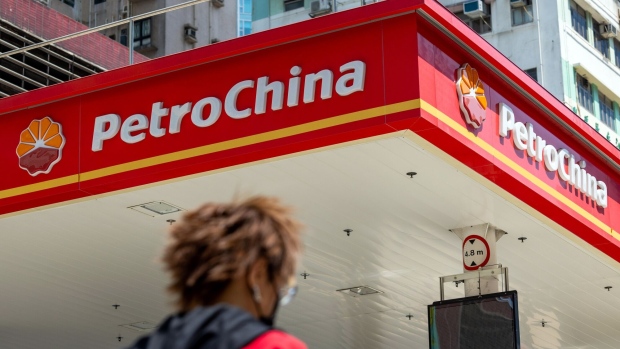Mar 27, 2024
PetroChina Boosts Green Ambitions as Big Oil Walks Back Pledges
, Bloomberg News

(Bloomberg) -- Fresh from posting record profits from drilling crude and pumping gas, China’s biggest oil company has promised that all of its output will be fueled by renewables come 2033.
By that date, “all drilling and refining activities will be powered by clean energy,” PetroChina Co. Chairman Dai Houliang told an earnings briefing in Hong Kong on Wednesday.
It’s a 17-year advance on the company’s earlier pledge to hit that target by 2050, and stands in stark contrast to some Western oil majors, which are walking back their clean energy ambitions as fossil fuels continue to drive profits.
Of course, using solar and wind to produce fossil fuels won’t make much of a dent in China’s climate goals when set against the impact of burning all that oil and gas to power cars and factories. But PetroChina’s intentions for renewables extend beyond just a headline-grabbing target.
Capacity Targets
The company expects to add 30 gigawatts of renewables capacity in 2024, about six times more than it has now, according to another executive at the briefing. China’s entire solar industry — by far the world’s largest — added 217 gigawatts last year, so that quantity coming from a fossil fuel giant isn’t to be sniffed at. Money will also be spent on expanding hydrogen, geothermal and carbon capture projects.
As a state champion, PetroChina is sometimes forced to juggle competing priorities. Beijing is keeping up the pressure to maintain oil output and boost gas production to keep the country from becoming too dependent on imported energy, and at the same time demanding progress on its net zero goals.
This year’s push on renewables will allow PetroChina to meet its broader objectives: new energy’s share of production needs to double from current levels to 7% by 2025, then climb to a third by 2035 and half by 2050.
The government’s influence extends to decisions taken throughout the company. While gas trading drove PetroChina’s profits in 2023, the company said that contracts this year will have to take account of what’s affordable for Chinese industry.
On the Wire
Australia will invest A$1 billion ($652 million) to ensure more solar panels are made domestically, as the nation looks to reduce its dependence on imports from China.
US Treasury Secretary Janet Yellen slammed China’s use of subsidies to give its manufacturers in key new industries a competitive advantage, at the cost of distorting the global economy, and said she plans to press China on the issue in an upcoming visit.
China’s wind turbine manufacturers dominated global supply last year, riding the nation’s renewables installation boom as a contraction in the US and meager growth in Europe dented overseas competitors.
China’s coal traders — men and women who keep the cogs of the fossil fuel-powered economy turning — have long been a gauge of its health.
The Week’s Diary
(All times Beijing unless noted.)
Thursday, March 28:
- China copper smelters quarterly meeting in Shanghai
- Boao Forum for Asia in Hainan, day 3
- China clean energy expo in Beijing, day 3
- EARNINGS: Maanshan Steel, Angang Steel, Metallurgical Corp., Ganfeng Lithium, Citic Ltd., Cosco Shipping, Yankuang, Goldwind, China Resources Gas
Friday, March 29:
- Boao Forum for Asia in Hainan, day 4
- China weekly iron ore port stockpiles
- Shanghai exchange weekly commodities inventory, ~15:30
- Shenhua online earnings briefing, 16:00
- EARNINGS: Jiangxi Copper, Shandong Steel
Saturday, March 30
- Nothing major scheduled
Sunday, March 31
- China’s official PMIs for March, 09:30
--With assistance from Kathy Chen and Dan Murtaugh.
(Updates with context from sixth paragraph)
©2024 Bloomberg L.P.





